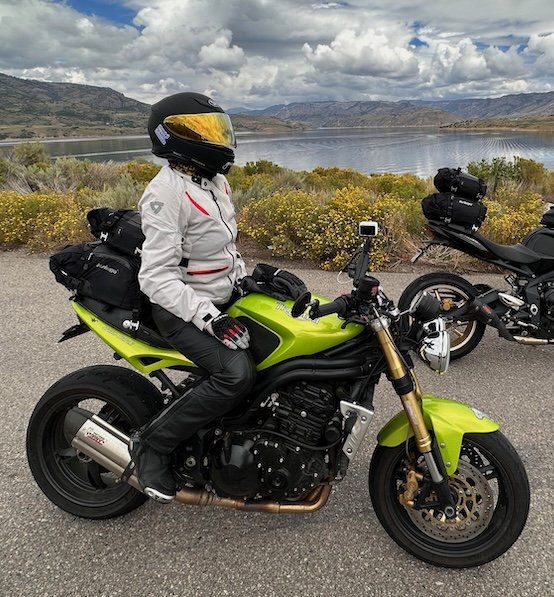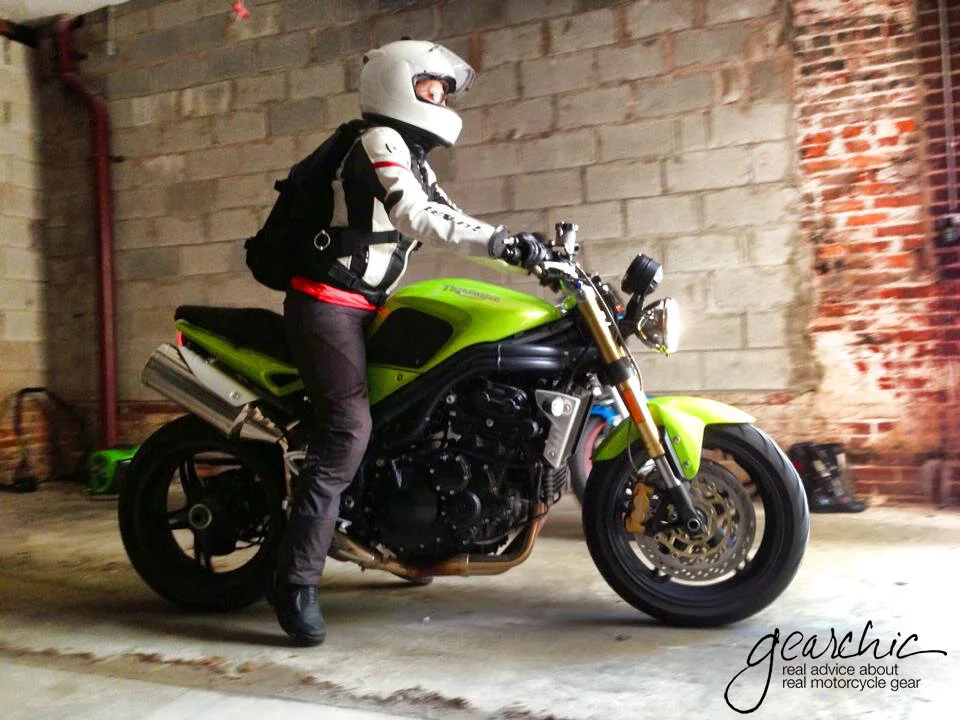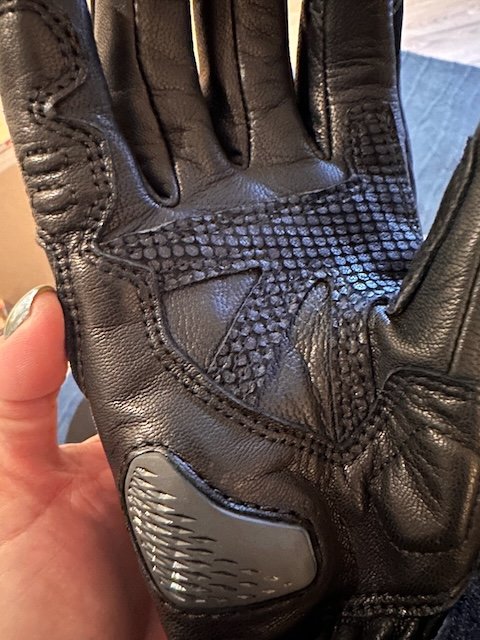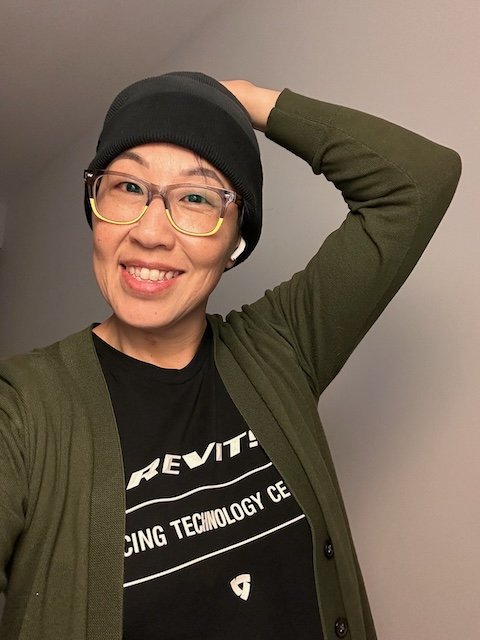Welcome!
As a very lucky woman, my friends and even some strangers have been extremely generous and trusting of my riding skills. So much so that I’ve been able to throw a leg over ~25 different types of motorcycles.
Me trying to be taller than my 6’ husband for once.
That list doesn’t show you how I was able to ride all of those bikes. So this is my how-to-guide that covers things that all new riders need help with. But when you’re this | tall, you may need to approach things a little differently because your lack of inseam means you have to compensate in other ways. This is not to say you can ride literally, every motorcycle in the world. This is to say “you can ride taller motorcycles than your measured inseam", and this is how”.
So, I'm short too: 5'2" (formerly 5'3" but apparently I'm shrinking in my old age) with a 28.5" inseam (when measured to the bottom of my foot).
However, I am blessed to have a slightly higher inseam than other people at my height, I know.
I want you to know that you won’t be limited to a motorcycle that matches your inseam. I've never flat footed both feet on a motorcycle except on an older Honda Rebel 250 and a (kid sized) 50cc dirtbike.
But I didn't let that stop me from riding what I wanted to ride and you can too!
Unfortunately, this didn’t happen overnight. It’s been a process and if you think that you’ll become an extremely proficient rider with enough skill to ride a bike that’s 5-10 years beyond your experienced level, you’re going to be very disappointed.
REMEMBER: It's not about how tall you are, but HOW WELL you ride.
Here’s what has worked for me over the years, and will make the biggest impact on your ability to ride almost any motorcycle you want.
I came up with this list after numerous riders have asked me about my riding and whether or not I lower them, how I ride what I ride, what I wear, etc. So here’s everything I can think of to help you on your journey to ride as if you’re taller than you are. ;)
1/ RidE Bikes that Make You Happy
I started on a 50cc scooter, but I wish I started on a 100-150cc motorcycle (because smaller motorcycles didn’t exist in the US back then)! Ha.
When you choose a motorcycle, there are a thousand things that will enter your mind as far as making such an important decision. Many times you are going to be driven purely by looks. Sometimes you’re driven by peer pressure. No matter what you buy, make sure that bikes makes you happy every time you ride it. If you're avoiding practicing, and don’t love RIDING your motorcycle (not just looking at it), that’s probably a red flag and something you should really think about whether or not you made the right decision.
I rode this sexy 50cc scooter, for a year with a 30” seat height. It was absolutely taller and no, I could not flat foot it whatsoever. So I learned to use one foot. It only weight 200lbs! And since I could step thru, it was super easy to manage the weight.
After almost 4,000 miles in one year of riding the Streets of San Francisco, I became really comfortable with being on 2 wheels and navigating traffic, learning how to lean a little bit, turn, everything. And I could easily do it with something super forgiving.
2/ Start out Small (displacement) and Work Your Way Up
Anything with a smaller displacement will be lighter, more nimble, lower center of gravity and probably skinnier overall.
You may just need some time and practice on a smaller, lighter bike until you gain enough riding experience to manage these weights, heights and dimensions.
Pro Short Tip: The key to learning to ride is literally, learning to ride.
It’s just like learning anything else; a new career, new hobby. It’s as if you’ve spent 10 years becoming a really good chef/cook/mechanic, did that take a Summer? a month?
You are also trying to get your body used to the feel of a heavy motorcycle. Since we are shorter, our center of gravity is raised simply because we are much closer to the bike than someone who is a few inches taller. That frame of reference is going to be crucial when you step up to a midsize or liter sized bike.
Me, driving a motorcycle for the first time in 2004.
Because I spent a year on the scooter, jumping on this and trying it (before my safety class) I felt comfortable just riding around the parking lot. My husband gave me a few literal tips on shifting and I rode around the parking area for ~10 minutes.
Also, keep in mind that larger tanks and larger displacement bikes might be wider between the tank. This is my husband’s Speed Triple which makes me feel miniature. It’s 1055cc and a 3 cylinder engine, so it’s not only heavier, but it’s also much wider between my knees. So that’ forces my feet outward, and that makes it even taller. Bc it pushes me out to my tiptoes. So much so, in fact that I can barely touch the ground with both feet at the same time. The only street boots I’ve been able to wear with both feet are my old Daytonas (which I really don’t wear anymore). Instead, I have to dangle one foot and only ride with one foot. It’s been a few years since I’ve ridden his bike too, so if I had to ride it today I’d probably drop it LOL.
3/ Tall and Light beats Low and Heavy
IF you have aspirations to ride taller, heavier bikes in the future, I recommend starting on something lighter and taller, because you will force yourself to get used to something that you Cannot flat foot. Start training yourself to stop on left foot first.
It's a dangerous tightrope when you're used to flat footing everything, because making the jump to a bike where you can only get the balls of your feet down is going to be a more difficult learning curve. You’ve taught yourself to rely on your feet this whole time, not so much your skills. Without two flat feet for stability, you have to compensate with your riding skills.
This is also why I am easily able to ride my 2019 Yamaha XT250! It weighs nothing, and it’s extremely skinny. The suspension is also soft, so when I sit with all ~130lbs of me, the bike actually squats down. In this picture, you’ll see I’m on my toes (and just wearing riding shoes, not boots)
ATRATT :: All the REV’IT! All The Time: Levante 2 H2O Jacket, Sand 4 Gloves, Marley Jeans, Krait GTX Shoes.
Pro Short Tip: If you sit on a bike and the suspension doesn’t move at all beneath you, it’s too stiff and set up for someone heavier. This is a sign that you need a different bike OR better suspension!
4/ Brake Like a Boss
Practice perfecting your braking skills! The better you brake, the easier it'll be to handle the 400lbs+beneath you. Get used to just putting your left foot down first, and keep that right foot on the rear brake until you accelerate again. I know that you may not need your rear brake to stop since many motorcycles have incredible stopping power from the front. However, to really finesse and smooth your braking you may need to practice adding (just a little) rear brake in order to maintain stability. Have you ever almost dropped your bike at a stop? It’s most likely because you didn’t use enough rear brake and let go before the bike actually stopped moving.
When you have a big that's taller and heavier, you have to compensate with this because you have to manage 400-500-600-700 lbs of force stopping suddenly.
If I’m riding the Speed Triple above, the ~425lbs of weight would throw me on the ground if I stopped suddenly and didn’t make sure my stopping time and distance was adequate so could use smooth, progressive braking.
My right foot rarely leaves the rear brake! Not for stopping power, but a little pressure for stability for smooth stops.
This also means wearing Real Protective Motorcycle Gloves.
If you invest in a really good pair of protective riding gloves (not just the pretty ones, not just the ones that match you bike), you will have better dexterity and more finite control over your clutch and brake. You can not make fine, micro adjustments to your throttle if you are wearing absolutely nothing on your hands, or if you are wearing non protective / technical gloves.
Your gloves should do the work for you, not the other way around.
If you are squeezing your grips too hard, your hands are always tired, you can’t maintain a good grip, you’re probably wearing the wrong gloves (or none at all!)
My Lacus GTX Ladies sport touring gloves.
5/ Wear protective, motorcycle footwear
Do NOT wear motorcycle footwear from the mall, or any online retail like Zappos (or other fashion focused retail) that doesn’t specialize in motorcycle specific, protective footwear. I rarely draw lines in the sand like this, but I can’t emphasize this enough.
Your partner/friend/whatever who’s 5’9-5’10” can get away with wearing easy, soft, whatever riding shoes/boots and manage the height/weight of a larger bike, no problem. Because guess what, they’re flat footing it most likely, right?
There’s far more leverage, traction and protection that will be provided if you invest in true protective, motorcycle footwear. You need literally, every centimeter of traction and support you can get. Being 5’2”, it’s not enough to wear “biker boots”.
First and most importantly, you will not be protected. at all.
Second, having Extra Traction is SO important, especially when you're shorter and you can't flat foot with both feet. I never could've upgraded to larger bikes without investing in great boots early on. The feeling you get when you put your feet down can make or break your perception of what you think you can do!
Looks can be deceiving but the compound and makeup of these Brecchia GTX shoes offer far more grip / traction on the pavement .
So this photo is of me riding a friend’s Triumph Street Triple (we have the same bike!) in 2018 at the Women’s Sportbike Rally. Notice that only the ball of my left foot is touching the ground. That’s all I need, because my boots have incredible traction, even in that tiny patch of rubber touching the ground. If the ground is smoothly paved and flat, I can back my bike up with one foot. Granted, it takes longer than with two, but I can do it. And this bike only weighs ~400lbs. So I certainly wouldn’t have that capability on say, a 500-600lb Adventure Bike.
Real motorcycle boots are very different from anything you’ll buy from a casual website like Zappos. I can almost guarantee you that anything you’re using now for non-motorcycling activities won’t have as much traction as a true riding boot. There are plenty of options, and if you choose a purpose-built riding boot (rather than just a cool looking one), you will have more stability and traction which translates to more confidence. But also control.
As smaller riders, you must learn how to control your motorcycle in every way, not just at speed. In parking lots, u turns, corners, everything, even better than the taller rider next to you.
Also, look for CE Certification, because that tells you the fact that your riding boots have been tested with more than just impact protection, especially the rigidity of the soles. If your soles are soft, squishy, comfortable, there’s absolutely NO way they can give you any leverage to push or park your 400+lb motorcycle.
Disclaimer: During your safety course, yes, wearing a casual piece of footwear is totally reasonable because you’re on the smallest/lightest bikes possible. This really applies to when you decide to purchase your motorcycle start riding!
6 /Patience & Practice
Me on my first Ninja 250. Wow! Look at my hiking shoes.
If you don't take the time to practice riding, every day (when weather permits) or as often as you possibly can you'll never progress when it comes to techniques and riding taller bigger bikes. Riding is more than just keeping it upright. The more you ride, the better you’ll get. Even better than the person next to you who’s 5” taller. Just because they’re taller doesn’t mean they know how to ride a motorcycle any better than you do. Celebrate the Small Wins!
You don’t need to ride an hour or three hours every day either. Try to commit to 15-20 minutes a day, minimum. At least 5 days a week. This guy says it only takes 20 hours. Try his method and let me know how it goes!
Just want to call out my hiking shoes here, and they were barely adequate. This was 1 week before my safety course and I just wanted to see what it was like. I was able to use just my toes, because remember, at this point I’d been doing that on a 200lb Scooter for the past 12 months! Absolutely NO WAY I would’ve been able to do this easily for the first time ever, without dropping this bike left and right. (I didn’t drop it at all during this short parking lot session).
7/ learn how to move your motorcycle
I almost always hop off my bike to park it. You don’t always have to stay on it to park it, and you don’t always have to hop off. But learning how to do this will save you grueling, stressful minutes if you’re stuck in a corner or have to make a quick exit and need to do a 3-5 point turn to get out of a tight spot.
Who says you HAVE to back it up and park while seated? Strategic parking is another way to make sure you will be able to easily leave any spot without needing anyone's help! Check out this blog post with my easy parking tips.
This is my old house in San Francisco. The driveway is too steep and narrow to do anything but backing it down into the garage.
With this, I will also add that you must ride your own ride, in the sense that just because your friends park in one spot, doesn’t mean you have to also.
When I’m with other riders, I don’t care where they park. I am always looking for the most flat, easy spot for me to park so I don’t have to back out of the spot uphill, or on an incline, or on a spot that will cause me to drop it.
I’m always looking for #1, that’s ME. Not my friends, no their bikes, and not what they’re doing. Secondly, they don’t care! If I park where my 6’ tall husband parks sometimes, he has to literally pull me out. If that means riding around the block and parking away from him, I DO. I tell him of course (in my helmet) but, I remind him that I can’t park there, or I need to park elsewhere because of something that’s in my way, or if I know I can’t maneuver out of the spot easily.
I’m truly a lazy person, so I’m always looking for the easiest way out!
8/ Increase Your Height WITHOUT BIKE MODIFICATION!
Lots of options like these on Amazon.
Just by adding some inserts, you can easily add 2-4 inches in the heel, so when you put your foot down, most of it will be touching the ground. And if you ride sportbikes like me, then the front of your boot won't be too thick to place under the shift pedal. Way less expensive and you won't lose ground clearance like you do when you lower your suspension. The insoles I linked also have multiple heels so you can experiment with how much height you really need. They also make heel only versions of these insoles as well. Just go to Amazon and search for “lifted insoles” or “heel inserts” or “height insoles” and you’ll find a ton of options.
I put these in my track boots and then I have a solid flat left on the ground (while my right is on my brake). It provides plenty of stability and I don’t feel the need to be flat on the right.
When it comes to lowering your bike (mine have always been unlowered), there are a lot of ways to do it. I simply don’t recommend this except as a last resort, and only by a suspension specialist because your back end needs to be in sync with your front. This is especially important with sportbikes. Always consult a professional suspension expert (not just your mechanic) to do this properly.
I also do this in my dirt boots.
9/ Have a Riding Strategy / Plan
If you’re brand, spanking new and you just got your license, you really want to start riding NOW. Not next week, not next month and certainly not next year. All the training you just received needs to be used as soon as possible, so you can start to build skills and especially muscle memory.
Remember, we have to ride really, really well because our skills are going to get us to taller bikes, faster.
Here’s a sample schedule / plan that you can use in the first 30 days to build as much confidence and start to really increase your skills. The more you practice/ride, the faster you build skills and confidence. The less often ride, the slower and steeper that learning curve is going to be.
This suggested schedule are for brand new, just licensed riders. If you can’t commit 20 minutes every day, then make it almost every day. This is You Time, so prioritize yourself and give yourself the time and attention you need to make your dream of riding motorcycles come true!
21 Days of Riding
day 1-7
Time: 20 minutes each day, so 7 (20) minute sessions of riding.
Location/Route: 3-5 miles within your neighborhood. Pick a route where you live that you are extremely familiar riding. Like you could drive it with your eyes closed because you know where every tree / stop sign / traffic light is. Preferably with lighter traffic or off main thoroughfares. When I lived in San Francisco, at the time I lived in the Presidio. I started only riding within the park to make sure I felt really comfortable within a shorter, smaller radius. This will eliminate any stress or frustration that might come up due to getting lost or uncomfortable with traffic.
DAY 8-14: repeat dayS 1-7
It’s crucial not to get overconfident and then shoot for the freeway. That’s not how this works. Your confidence will be defined by the radius you’ve created, so it’s important that you build that radius slowly.
DAY 15-21:
Time: 20 minutes each day, so 7 (20) minute sessions of riding.
Location/Route: 6-8 miles within your neighborhood. Pick a new route destination that’s still a familiar, easy place you’ve been to before. For me it was going to work. After I left the Presidio, I set out to ride from there to the Financial District across town. Instead of following the major thoroughfares like Van Ness Avenue, I skipped that and took all the side / back streets which increased my ride time from 20 minutes to 40 minutes, but I carved out plenty of time. You certainly don’t have to do that, but find another spot on the map that you’re really familiar with as your next destination which makes for a 6-8 mile round trip. Again, somewhere you’ve been a million times and can find without directions.
This repetition is going to build a level of confidence that you need to move to the next level after that, 10-15 miles, 15-20 miles. And repeat as much as you think you need. There are no rights/wrongs ways to do this, just that you build your confidence enough for you to move further out. But don’t move your radius until you’ve confidently built your braking and maneuvering skills.
It’s like when you were in your first couple of sessions of your MSF class, and you had to learn to stop and start before you could move on to doing any turning maneuvers.
If you don’t master the very basics, you’ll never move forward with the skills and confidence you need to learn the next set.
10/ MAKE YOUR OWN DECISIONS
This is the easiest most achievable, most affordable thing you can do.
Do not let someone taller, with more experience decide FOR you. Absolutely, get their input and guidance, hear what they have to say. But even me, yes, I don’t want you to just blindly accept what I say without some researching and asking other riders what has worked. Draw your own conclusions. Use none of my tips, some of my tips, whatever!
You must decide for yourself, what motorcycle you’re riding, for example. If you can’t answer the most basic “what do you ride?” question, how can you possibly be in control of your motorcycle? If riding choices are made by others, you are completely unprepared for what’s ahead of you. Accepting a free motorcycle is great and all, but at what cost?
With this, be prepared to acknowledge and accept any mistakes you make, because you must learn from them. If you have to sell the bike you bought bc you screwed up, then sell it. If you need to say no to your partner’s generous offer, then you need to say no.
Lastly, try not to let someone else lead you without asking questions and making informed decisions about your riding career. <3 Joanne






















